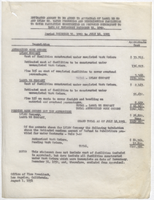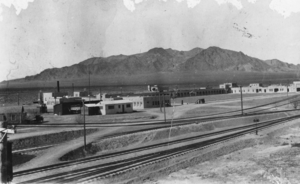Search the Special Collections and Archives Portal
Search Results

Report on costs of reproduction at various water production properties owned by Los Angeles & Salt Lake Railroad Company, August 1, 1951
Date
Archival Collection
Description
Estimated amount to be added to appraisal of Los Angeles & Salt Lake Railroad Company and Las Vegas Land and Water Company water producing and distribution facilities to cover facilities constructed or proposed subsequent to date of inventory December 31, 1950. Estimated cost of reproduction new and less depreciation of water production and transmission facilities. Itemized list of improvements made by the water company subsequent to the previous inventory.
Text

View of Death Valley Junction, California: photographic print
Date
Archival Collection
Description
From the Nye County, Nevada Photograph Collection (PH-00221) -- Series VII. Other areas in Nye County -- Subseries VII.F. Lowe Family. Shortly after the hotel was constructed, the Pacific Coast Borax Company constructed a swimming pool and planted a number of trees in the square. The building at the left end of the square is the company store. An infirmary was established at the right end of the square. Uppermost track going off to the left toward the middle of the photo is the narrow gauge to Ryan. Funeral Mountains are in the background.
Image
Roy Waite oral history interview
Identifier
Abstract
Oral history interview with Roy Waite conducted by Dale Haley in approximately 1974 for the Ralph Roske Oral History Project on Early Las Vegas. Waite begins by discussing his athleticism, being a part of the first basketball team in Las Vegas, Nevada, and his general store in Bunkerville, Nevada. Waite lists the different social organizations and boards he was affiliated with, describes the arrival of the railroads, and the ranch he used to own near Bunkerville. He talks about the construction of Hoover Dam (Boulder Dam) and how Southern Nevada has changed socially and environmentally. Waite also discusses smelting lead for bullets and relocating Native American remains away from a grave site that would be submerged by Lake Mead.
Archival Collection
David Bedford Photograph Collection
Identifier
Abstract
The David Bedford Photograph Collection (approximately 1980-1984) is comprised of twenty color photographic prints that depict the Las Vegas, Nevada Ice House, which was constructed to aid transportation of perishable goods for the Los Angeles and Salt Lake Railroad.
Archival Collection
Jeff McColl Sr. oral history interview
Identifier
Abstract
Oral history interview with Jeff McColl Sr. conducted by Dennis L. Weigang on March 09, 1976 for the Ralph Roske Oral History Project on Early Las Vegas. In the interview, McColl discusses his early life moving back and forth between California, Nevada, and Texas before settling in Las Vegas, Nevada in 1925. McColl also discusses his work as a locomotive engineer for the Union Pacific Railroad Company, life in Las Vegas during the late 1920s and 1930s, and industrial and urban growth in Las Vegas.
Archival Collection
Paul M. Lytle oral history interview
Identifier
Abstract
Oral history interview with Paul M. Lytle conducted by James Greene on December 19, 1974 for the Ralph Roske Oral History Project on Early Las Vegas. In the interview, Lytle discusses moving to Boulder City, Nevada in 1936 to work as a Boulder (Hoover) Dam guide. Lytle also discusses his early life moving around Nevada, his family, his experiences with railroad freight cars, Boulder Highway's road conditions and roadside stores, and his service in the United States Army during World War II.
Archival Collection
Mallory H. Ferrell Photograph Collection
Identifier
Abstract
The Mallory H. Ferrell Photograph Collection (approximately 1900-1935) is comprised of nine black-and-white photographic prints depicting railroads, locomotives, and mines in Tonopah, Nevada and Tecopa, California.
Archival Collection
Fred and Maurine Wilson Photograph Collection
Identifier
Abstract
The Fred and Maurine Wilson Photograph Collection depicts the Wilson Family, events, and locations in Las Vegas, Nevada and the Southwestern United States from approximately 1860 to 1990. The photographs primarily depict early Las Vegas, including the Mormon Fort and Kiel Ranch; mines, towns, and railroads in Southern Nevada; the construction and planning of the Hoover (Boulder) Dam on the Colorado River; and the Wilson Family. The photographs also include prominent Las Vegas families such as the Park Family, aerial photographs of the city, landmarks on Fremont Street and downtown Las Vegas, and desert landscapes.
Archival Collection
Howard Wasden oral history interview
Identifier
Abstract
Oral history interview with Howard Wasden conducted by Gillian Collins on an unknown date in the 1970s for the Ralph Roske Oral History Project on Early Las Vegas. In this interview, Wasden discusses arriving in Las Vegas, Nevada in 1925 and working for the railroad. Wasden explains how the railroad was a predominant economic asset for Las Vegas at the time. He then describes living on the Westside "Old Town", education in Las Vegas, attending the University of Nevada, Reno, and eventually becoming a teacher. Lastly, Wasden discusses the population growth, development of the Las Vegas Strip, and his role as principal of West Charleston School.
Archival Collection
Albert C. Phillips Photograph Collection
Identifier
Abstract
The Albert C. Phillips Photograph Collection is comprised of sixteen black-and-white photographic reprints and four photographic negatives depicting buildings in Caliente, Nevada which were originally taken between 1900 to 1967 and reproduced in approximately 1999 to 2005.
Archival Collection
